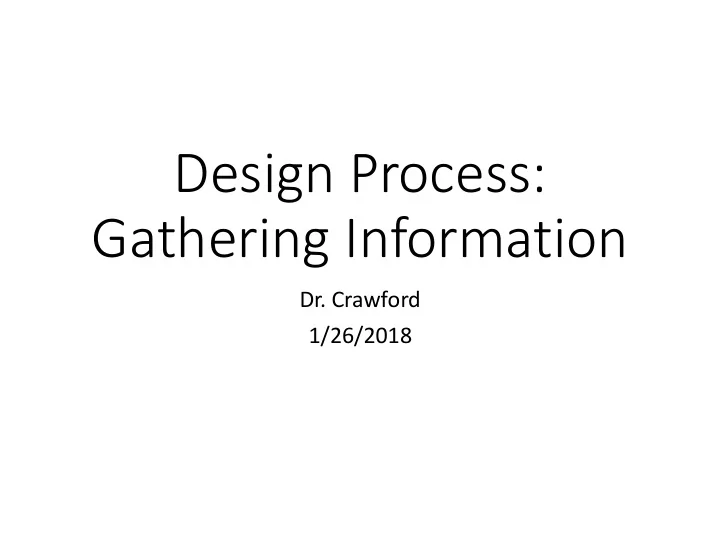

Design Process: Gathering Information Dr. Crawford 1/26/2018
Overview • How to gather information • Identifying necessary information • Types of design information • Sources of design information • Final Comments
How to Gather Information Now that we know something, Identify Necessary what else do we need to know? Information What do we need to know? Gather Information Handbooks, Patents, Internet, etc. Analyze, Categorize, Summarize Write it up
Identifying Necessary Information Identifying necessary information starts by asking the right questions. • What is our application? What do we need to know about this application? • How is this problem or similar problem solved today? What are the current designs? What is the state-of-the-art? What are the materials that are used for these applications (why)? • What is unique about our problem?
Design Project Example Problem Statement: Design a rapid screening method, to be used by ATI Specialty Metals, for Inconel 718 connection bolts used in sub-sea oil and gas applications to prevent premature environmentally assisted fracture. Questions: • Who is ATI? What do they do? • What is Inconel 718? • Typical applications, properties, physical metallurgy, processing conditions • What is environmentally assisted fracture? • What are the current testing methods? • What is the nature of common failures and incidence rate? • Existing specifications? • Others?
Types of Design Information Types of Information (the big ones): • Customer • What do they do? • What do they need? • Existing/Related Solutions/Products • What is the state-of-the-art? • What materials are currently used? • What are the performance/ environment requirements? • Cost Information • Process, materials, etc. • Applicable standards • Are there related ASTM or ISO standards?
Information Sources The big ones: • Search engine (e.g. google) • Technical Journals • Web of science • Google scholar • Industry/Engineering handbooks • ASM Metals Handbook • Heat treaters guide • Patent Search • Google Patent • USPTO • Customer feedback • Personal Network!! • Colleagues, co-workers, faculty, etc.
Journal Article Electronic Databases
Finding Literature On Campus • http://www.sdsmt.edu/Academics/Library/Resourc es/ElectronicResources/ • Web of Science • Search for journal articles • Knovel • ASM Metals Handbook (23 volumes!!) • Heat treaters guide (ferrous and non-ferrous) • Interlibrary Loan • http://www.sdsmt.edu/Academics/Library/Interlibrary- Loan---Request-Delivery/
Summarizing Information What To Do 1. Organize your information and make an outline 2. Create a bibliography (reference list) 3. Write a concise summary for each topic in your outline using various resources you have gathered. 4. Reference your summary within the text. What Not To Do 1. Write a series of paragraphs/sections that summarize information from a single reference source. 1. Information is not organized and is not useful or informative.
Final Comments • Look before you leap • Don’t reinvent the wheel • Don’t waste time – search smart • Take notes – and make sure to summarize them • Communicate your new knowledge with your team!!
Recommend
More recommend